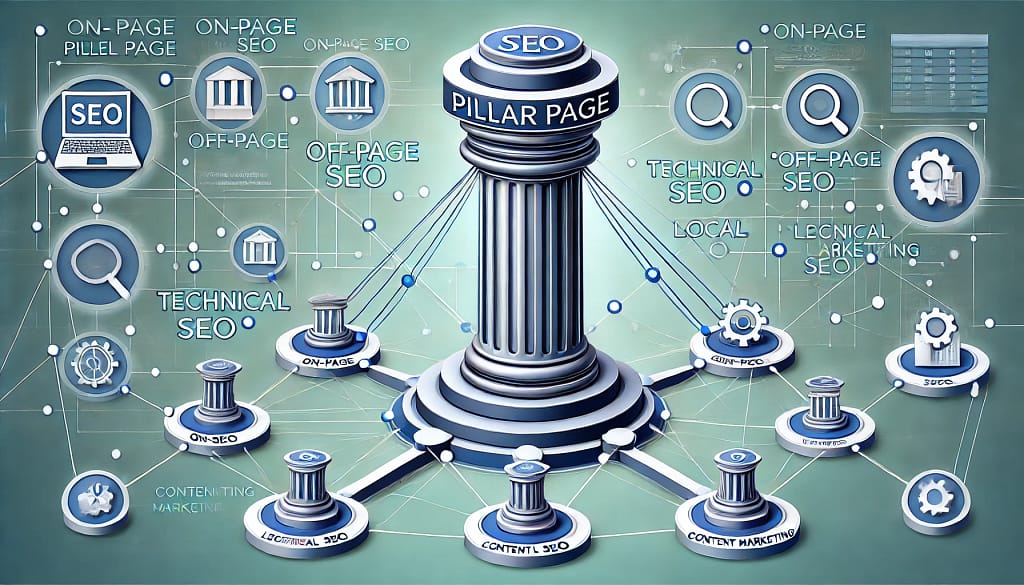
Pillar Pages and SEO
Pillar pages and SEO, a way to Elevate Your Content Strategy
In the evolving world of digital marketing, two critical elements have emerged as game-changers: pillar pages and SEO. While traditional keyword strategies are still relevant, they are no longer sufficient on their own. With search engines like Google becoming increasingly sophisticated in understanding user intent and context, creating content that serves both your audience and SEO objectives has become more complex and nuanced. This is where the concept of pillar pages comes in—a strategy being heavily promoted by platforms like HubSpot.
What Are Pillar Pages?
A pillar page is a comprehensive, in-depth piece of content that focuses on a specific core topic. Think of it as the foundation upon which a cluster of related content pieces—such as blog posts, articles, videos, or other resources—are built. These pages are designed to cover a topic in its entirety, providing a broad overview while linking to more detailed subtopics.
For example, a marketing agency might create a pillar page titled “The Ultimate Guide to SEO.” This page would cover all aspects of SEO, from on-page and off-page SEO techniques to technical SEO, backlinks, local SEO, and more. Each of these aspects would be discussed briefly within the pillar page and then linked to more in-depth articles or resources that dive deeper into each subtopic. This not only provides value to the reader but also signals to search engines that the page—and, by extension, the website—is an authoritative source on that topic.
Why Are Pillar Pages Important for Your Content Strategy?
Pillar pages are a cornerstone of modern content strategies for several reasons:
- Establish Authority: Google and other search engines prioritize authoritative content that provides comprehensive answers to users’ queries. A well-constructed pillar page showcases your expertise in a particular area, positioning your website as a go-to resource for that topic. This authority is critical for ranking high in search engine results.
- Improve User Experience: Users visiting your site are often looking for answers to their questions. By providing a single, comprehensive page that links to various related resources, you help users find the information they need more efficiently. This improves user experience, reduces bounce rates, and increases the time spent on your website—all of which are positive signals to search engines.
- Optimized for User Intent: Search engines have shifted from focusing solely on keywords to understanding the context and intent behind a user’s search. Pillar pages allow you to create content that directly aligns with what users are looking for, which enhances your chances of ranking for those topics.
- Encourage Interlinking: By linking subtopics back to the main pillar page and vice versa, you create a web of interconnected content. This interlinking structure not only helps users navigate your site but also allows search engines to better crawl and understand the relationship between different pieces of content.
- Boost SEO Performance: Pillar pages are a natural fit for inbound marketing strategies. By creating valuable, comprehensive content, you attract inbound links from other authoritative websites. These backlinks further enhance your site’s authority, helping it rank higher in search results.
The Difference Between Topics and Keywords
To understand how pillar pages fit into a broader SEO strategy, it’s essential to differentiate between topics and keywords.
- Keywords are specific search terms that users type into search engines. They are often short phrases or words like “local SEO” or “link building.”
- Topics, on the other hand, are broader, overarching categories that encompass multiple related keywords. For example, “SEO” is a topic that includes various keywords like “on-page SEO,” “off-page SEO,” “technical SEO,” and more.
Google’s algorithms have evolved to understand these broader topics, rather than just focusing on individual keywords. This shift, particularly since the introduction of Google’s Hummingbird update, means that to rank well, your content must demonstrate comprehensive expertise on a topic, not just optimize for specific keywords.
How Pillar Pages Fit into Modern SEO
Since Google’s Hummingbird update, which began focusing more on context and relational search, the need to prove topic authority has become paramount. This is where pillar pages come in. A pillar page functions as a core piece of content that demonstrates your deep understanding of a topic. It’s not just a high-level overview; it delves into the intricacies and nuances of the subject matter, providing users with a wealth of information that answers their queries thoroughly.
Creating a pillar page involves compiling an in-depth guide that is divided into sections covering different aspects of the topic. Each of these sections should target specific keywords and link out to more detailed content on your website that further elaborates on those subtopics. For example, in a pillar page on SEO, sections could include:
- On-Page SEO: Covering content optimization, meta tags, header tags, etc.
- Off-Page SEO: Discussing backlinks, social signals, etc.
- Technical SEO: Exploring site speed, mobile-friendliness, crawl errors, etc.
- Local SEO: Focusing on optimizing for local search results.
By linking each of these sections to separate, more detailed blog posts or articles, you create a robust content network that showcases your authority and helps both users and search engines understand the breadth and depth of your expertise.
Building the Perfect Pillar Page
To create an effective pillar page, consider these best practices:
- Select a Core Topic: Choose a broad topic that is relevant to your business and has a high search volume. This should be a topic that you want to be known for—something that reflects your core competencies and aligns with your business goals.
- Conduct Thorough Research: Understand what users are searching for related to this topic. Use tools like Google Keyword Planner, SEMrush, or Ahrefs to find popular keywords and queries. This will help you structure your content around what your audience wants to know.
- Create Comprehensive Content: Write a long-form piece that covers the topic extensively. Aim to answer all possible questions a user might have. Use subheadings, bullet points, images, and other media to make the content digestible.
- Interlink Subtopics: Link from your pillar page to related blog posts or articles on your website. Each of these subtopics should also link back to the pillar page to create a web of interconnected content.
- Optimize for SEO: Use relevant keywords naturally throughout your content. Include meta descriptions, alt text for images, and ensure your site is mobile-friendly and fast-loading.
- Promote Your Content: Share your pillar page across various platforms—social media, email newsletters, guest posts, etc. The goal is to attract backlinks from high-quality third-party sites, which will enhance your site’s authority.
Common Pitfalls and How to Avoid Them
Many businesses fall into the trap of thinking that creating a pillar page alone will automatically drive traffic and improve rankings. However, without the right effort in terms of promotion, interlinking, and backlink building, even the best content can fail to perform. Here are a few tips to avoid common mistakes:
- Don’t Forget Internal Linking: Make sure your pillar page is linked to other relevant content on your site, and vice versa. This helps search engines understand the relationship between pages and boosts your site’s overall authority.
- Avoid Poor Quality Backlinks: Focus on acquiring backlinks from reputable, high-quality sites. Poor quality or spammy links can do more harm than good.
- Promote Beyond Just Your Website: Leverage social media, guest blogging, and other channels to promote your pillar page. The more visibility it gains, the better it will perform.
- Consistently Update Your Content: SEO is not a one-and-done effort. Regularly update your pillar page with fresh, relevant content to keep it valuable to both users and search engines.
The Power of the Pillar Page Strategy
A well-executed pillar page strategy can transform your content and SEO approach, leading to higher traffic, better rankings, and more meaningful engagement with your target audience. Remember, the goal is not just to attract visitors but to educate them and guide them further along their buyer’s journey, ultimately driving them to take action—whether that’s subscribing to a newsletter, downloading a resource, or making a purchase.
By investing time and resources into creating high-quality, authoritative content through pillar pages, you position your business as a leader in your field, build trust with your audience, and stay ahead in the competitive digital landscape. So, start crafting your pillar pages today, and watch as they become the pillars that support your growth and success.
SEO optimizer GPT
A GPT tool for dynamic SEO analysis and blog optimization.
If you need any more help or have any other requests, feel free to ask! 🌟
Q&A
How do backlinks affect SEO?
Backlinks, or inbound links, are links from one website to another, and they play a crucial role in search engine optimization (SEO). Here’s how they affect SEO:
1. Authority and Trustworthiness
- Domain Authority: Search engines, like Google, consider backlinks as votes of confidence. High-quality backlinks from reputable sites enhance your website’s authority.
- Trust Signals: When trustworthy sites link to yours, it signals to search engines that your content is credible and valuable.
2. Improved Rankings
- Higher SERP Positions: Websites with a strong backlink profile often rank higher in search engine results pages (SERPs). This is particularly true if the backlinks come from relevant, high-authority domains.
3. Referral Traffic
- Direct Visitors: Backlinks can drive direct traffic to your site when users click on them. This can lead to increased engagement and potential conversions.
4. Indexing
- Faster Discovery: Search engines use links to discover new content. High-quality backlinks can lead crawlers to index your website more quickly.
5. Relevance
- Contextual Links: Backlinks from sites in a similar niche or industry are more valuable. Relevant links can help establish your site’s theme and relevance for specific keywords.
6. Anchor Text Optimization
- Keyword Relevance: The text used in a backlink (anchor text) can provide context about the linked page. Optimized anchor text can improve your rankings for specific keywords.
7. Competitive Edge
- Benchmarking: Analyzing competitors’ backlinks can provide insights into their strategy, helping you identify opportunities to improve your own backlink profile.
8. Reduction of Bounce Rate
- Engagement: Quality backlinks, especially from relevant sources, can attract more interested visitors, potentially lowering bounce rates and improving overall site performance.
Types of Backlinks
Natural Links: Earned through quality content without any effort.
Manually Built Links: Acquired through outreach and collaboration.
Self-Created Links: Links created by submitting content to directories or forums, though these should be approached cautiously to avoid spammy practices.
Best Practices for Backlinks
- Focus on quality over quantity: A few high-quality backlinks are more beneficial than many low-quality ones.
- Diversify your backlink profile: Aim for links from various sources and types of content.
- Avoid black-hat techniques: Steer clear of link schemes, buying links, or spamming as these can lead to penalties.
In summary, backlinks are a vital component of SEO strategy, influencing both rankings and authority in search engines. Building a robust and high-quality backlink profile can significantly enhance your website’s visibility and performance.
Why is keyword research important for SEO?
Keyword research is a fundamental aspect of SEO for several reasons:
Understanding Audience Intent: By identifying the keywords that potential customers are using, you gain insights into their needs, questions, and purchase intentions. This helps tailor your content to answer their queries effectively.
Content Strategy: Keyword research informs your content creation strategy. By focusing on relevant keywords, you can create valuable, targeted content that resonates with your audience, increasing engagement and shares.
Competitive Analysis: Analyzing the keywords your competitors rank for helps you identify gaps in your own content and uncover new opportunities to target less competitive or niche keywords.
Traffic Potential: Understanding search volume and competition levels for specific keywords helps you prioritize which terms to target. High-traffic keywords with manageable competition can drive significant numbers of visitors to your site.
On-Page Optimization: Keywords inform your on-page SEO practices, including title tags, meta descriptions, headers, and body content. Proper optimization helps search engines understand your content better, improving your chances of ranking higher.
Improved ROI: Targeting the right keywords can lead to higher conversion rates. By aligning your content with what users are actually searching for, you can attract more qualified leads that are more likely to convert.
Ad Campaign Efficiency: For paid search campaigns (like Google Ads), keyword research is crucial to ensure your ads are shown to the right audience, optimizing your ad spend and increasing return on investment.
Trend Identification: Ongoing keyword research allows you to spot emerging trends and shifts in user behavior, enabling you to adapt your strategy and stay relevant in a changing market.
Long-Term Strategy: Building a solid keyword strategy helps in long-term planning and defining your website’s niche, enhancing your brand authority and establishing a loyal audience.
In summary, keyword research is not just about optimizing for search engines; it’s about understanding your audience and delivering the content they are seeking. This strategic approach is essential for achieving sustainable growth and visibility online.
Can you explain the difference between on-page and off-page SEO?
Certainly! On-page SEO and off-page SEO are two crucial components of search engine optimization that focus on different aspects of improving a website’s visibility in search engine results.
On-Page SEO
Definition: On-page SEO refers to the optimization techniques applied directly within your website to improve its rankings and user experience.
Key Elements:
Content Quality: Well-researched, relevant, and engaging content that meets user intent.
Keyword Optimization: Strategic placement of target keywords in titles, headers, meta descriptions, and throughout the content.
HTML Tags: Proper use of title tags, header tags (H1, H2, etc.), and alt attributes for images.
User Experience (UX): Factors like website design, page load speed, mobile-friendliness, and intuitive navigation.
Internal Linking: Linking to other pages within your site to enhance navigation and distribute page authority.
URL Structure: Clean, readable URLs that include relevant keywords.
Off-Page SEO
Definition: Off-page SEO refers to actions taken outside of your own website to influence its authority and ranking in search engine results.
Key Elements:
Backlinks: Acquisition of high-quality inbound links from reputable and relevant websites. These links act as votes of confidence for your content.
Social Media Engagement: Promoting content on social media platforms to drive traffic and increase brand awareness.
Guest Blogging: Writing articles for other websites to earn backlinks and tap into new audiences.
Influencer Marketing: Collaborating with industry influencers to reach a wider audience and boost credibility.
Online Directories and Citations: Listing your business on online directories, which can improve local SEO and credibility.
Reputation Management: Managing reviews and online presence to build trust with users and improve perceived authority.
Summary
In essence, on-page SEO focuses on optimizing elements within your own website, while off-page SEO centers around building authority and reputation through external factors. Both are essential for a comprehensive SEO strategy aimed at improving search engine rankings and driving traffic.
Thank you for reading and sharing!

Invest in your future & learn
Learn affiliate marketing & build your own website.
Heads up! Make sure you sign up using my referral link to get access to my personal coaching and all features.
👉 Sign Up




